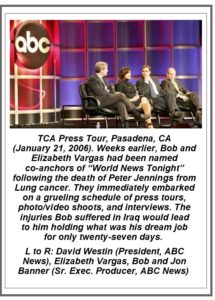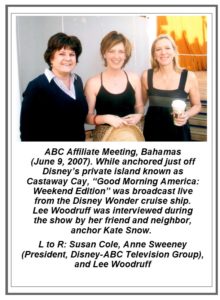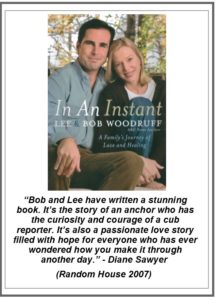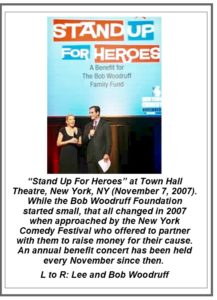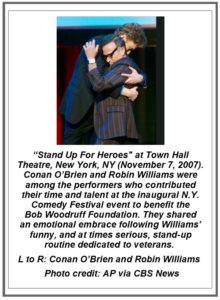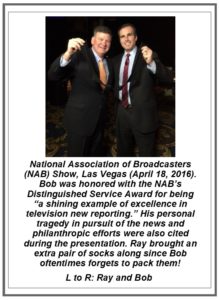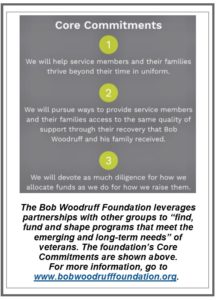“When I realized there was a job that existed in this world where I could be in the middle of huge world events and actually get paid for it, it was an epiphany for me.”
~Bob Woodruff, ABC News correspondent and co-founder of the Bob Woodruff Foundation, in “Hangin’ with Winners”
Robert Warren “Bob” Woodruff is a award-winning television journalist who has, quite literally, been to hell and back. On January 29, 2006, Bob and photographer Doug Vogt were reporting for ABC News on U.S. and Iraqi security forces near Taji, Iraq. They were seriously injured by a roadside bomb that struck the vehicle they were riding in. Bob received a traumatic brain injury that nearly killed him. The story of his amazing recovery and the manner in which the family was able to survive such a heartbreaking ordeal serves as a model for coping with tragedy.
Bob and I first met during an ABC Affiliates Association board of governors meeting in New York City on December 8, 2005. He and Elizabeth Vargas had just been named co-anchors of ABC’s World News Tonight to fill the seat of the late Peter Jennings (see his WINNER profile). “I am honored and humbled by this new assignment,” Bob said at the time. “Peter Jennings set a standard that all of us aspire to meet. Following in his path as co-anchor of this broadcast is a weighty challenge but it’s also an opportunity for Elizabeth and me to help ensure the broadcast lives up to his ideals, and continues his unwavering commitment to covering the world.”
The affiliate board initially had some reservations about the first dual-anchor, male-female team on a network evening newscast since the low-rated pairing of Dan Rather and Connie Chung on CBS a decade earlier. But Woodruff, Vargas and ABC News president David Westin alleviated those concerns as they discussed their vision for the future, including an ambitious plan to broadcast live in three time zones. I recall leaving the meeting impressed by — and happy for — Bob and Elizabeth, and relieved that the network and its affiliates were about to emerge from the long holding pattern we’d been in since Peter’s death four months earlier.
Bob Woodruff would hold his dream job for only twenty-seven days. He travelled to Israel to report on the aftermath of the 2006 Palestinian elections, and then moved on to Baghdad for a series of reports just ahead of President George W. Bush’s State of the Union address. It was there that he and photographer Vogt were embedded with the U.S. 4th Infantry Division. The armored vehicle they were riding in was hit by an improvised explosive device, and both suffered serious injuries. They underwent immediate surgery for head injuries, their lives now in the hands of a joint Army/Air Force neurosurgical team at the U.S. Air Force hospital south of Balad, located in Camp Anaconda. During the overnight hours, Woodruff and Vogt were evacuated to the U.S. Army’s Regional Medical Center near Landstuhl, Germany, the largest military hospital outside of the continental United States. Bob was kept in a medically-induced coma for 36 days to assist his recovery. He would later undergo more surgeries at Bethesda Naval Hospital in Bethesda, Maryland and at Columbia-Presbyterian Medical Center in New York City during what was a lengthy, painful and difficult process en route to recovering from his devastating brain trauma.
Following months of recuperation and only a month after doctors had given him a new skull, Bob returned to the ABC newsroom for the first time on June 13, 2006. He was accompanied by his wife Lee, David Westin, and veteran ABC journalist Charlie Gibson. Elizabeth Vargas had previously resigned her World News Tonight co-anchor position in May 2006 due to an upcoming maternity leave, and a desire to spend more time with her family. Gibson had been subsequently named sole anchor of the show. “It felt like coming home,” Bob said later about the emotional reunion with his caring colleagues.
Coincidentally, I had been elected chairman of the board of governors the month before on May 17, 2006. David Westin and I talked privately during those meetings about finding the right time for me to reach out to Bob on behalf of the entire affiliate body. Later that summer David provided me with a phone number to make just such a call, and I left a message for Bob to let me know when he was up to having a conversation. Bob returned my call a few days later, and I was able to convey the ongoing concern and support from affiliates for what he and his family had endured. It was evident that having such a conversation was still an effort for Bob as he chose his words in a slow and deliberate manner. But what was just as clear was his undeniable determination and indomitable spirit. I would learn months later that Bob struggled with expressive aphasia for more than a year, which is not surprising given the extent of his brain injury. He said, “Each day the words come more easily.” I concluded our call by conveying to Bob that, like his network colleagues, newsrooms at affiliated stations across the country were looking forward to his return to a profession that he loved so very much … and was so damned good at.
In February 2007, just thirteen months after being wounded in Iraq, Bob returned to ABC News with his first on-air assignment. To Iraq and Back: Bob Woodruff Reports was a documentary about his experience and it was presented on ABC in primetime. Through interviews with his family, the military medical teams that miraculously saved his life, and the ABC News crew and soldiers with him on that fateful day, Bob told the story about his journey to Iraq and back. He also returned to the field to report the stories of brave young soldiers and marines who, like him, were recovering from Traumatic Brain Injury – or TBI – which would later become known as the signature injury of the Iraq war.
Bob Schieffer, the iconic CBS journalist, said this about the To Iraq and Back documentary: “Then there is Woodruff, who went to Iraq to get one story, was badly wounded and after months of treatment recovered to find another: the unacceptable way that many who suffered the kind of serious brain injury he suffered were lost in a nightmare of red tape and going without the treatment they needed. The rest of us should have paid more attention.” It was a gripping hour of television, and signaled loud and clear that Bob Woodruff was back.
It was around the same time that Bob and Lee Woodruff published a best-selling memoir about their journey. It was written by the two of them together in what had to be the ultimate “couples therapy” exercise. Their writing relied heavily on the daily journals Lee had maintained in the months following the tragic incident, while Bob contributed his nightmarish recollections of the experience in words only he could express. The book chronicled Bob’s injuries, and spelled out in very personal terms how their family persevered through such an intense ordeal. For more on Bob’s story, and the love and incredible support of his wife and family, read In An Instant: A Family’s Journey of Love and Healing by Lee & Bob Woodruff (Random House, 2007).
Even a cursory review of the facts surrounding the carnage caused by the January 2006 roadside blast could lead one to logically conclude that Bob’s injuries should have killed him. “The inspiring thing is that sometimes, there are better things that occur because of what happened,” he told PEOPLE magazine. “A lot got worse, certainly in the beginning, but some things turned out to be a little better than we thought. They just took us on a different path.” That so-called path led to the establishment of the Bob Woodruff Foundation (BWF) which raises money for injured service members, veterans and their families.
On November 7, 2007, the BWF partnered with the New York Comedy Festival to present the inaugural Stand Up for Heroes event to raise funds for, and an awareness of, the foundation. The network and affiliate board happened to be meeting in New York that same week. We all gathered in the Good Morning America studios in Times Square for a reception beforehand, and then walked around the corner to the Town Hall Theatre for the show featuring Conan O’Brien, Robin Williams and Bruce Springsteen. It was inspiring to take note of the special bond Bob had with the wounded warriors in attendance, a unique kinship that would only deepen and develop further in the years to follow.
Since its inception, the BWF has worked passionately to support the emerging and long-term needs of veterans, including mental health, caregiver support, food insecurity and service-connected fertility issues. It has invested more than $85 million in programs that have empowered veterans, active-duty military and their family members.
It was an honor to be with Bob in April 2016 at the annual National Association of Broadcasters (NAB) Show in Las Vegas, NV. He was presented the NAB Distinguished Service Award which recognizes significant and lasting contributions to the broadcasting industry. “Bob Woodruff is a shining example of excellence in television news reporting,” said then-NAB President and CEO Gordon Smith. “From Afghanistan to Iraq to North Korea, Bob has been on the front lines of the most important stories. The personal tragedy he has faced in pursuit of the news, in addition to his philanthropic efforts, make him more than qualified for NAB’s highest honor.”
Shortly before returning to work at ABC News in February 2007, Bob talked about how so very close he came to dying. He spoke about the marble-sized rock once lodged against a carotid artery leading to his brain. “Had that rock traveled one more millimeter,” he said, “I would have been dead. It’s a miracle I’m alive.”
Bob and Lee, reflecting on his unimaginable injury and that miracle, said the following in the Afterword of their book: “Goodness and healing needed to emerge from such a devastating event.” Their philanthropic efforts have more than cleared that bar. Bob is a WINNER and shining example of excellence in all aspects of life: work, marriage, family … and giving back.
NAB “Distinguished Service Award” Presentation Video
Video Credit: ABC News/NAB
Sources
Books –
In An Instant: A Family’s Journey of Love and Healing by Lee & Bob Woodruff (Random House, 2007)
Websites –
“Bob Woodruff Official Biography” Retrieved from www.abcnews.go.com
“To Iraq and Back: Bob Woodruff Reports” Retrieved from www.thedocumentarygroup.com
“Bob Woodruff Foundation – Investing in the Next Chapter for Our Veterans” Retrieved from www.bobwoodrufffoundation.org
“13th Annual Stand Up for Heroes kicks off New York Comedy Festival and raises over $5.7 million to support veterans through the Bob Woodruff Foundation” Retrieved from www.bobwoodrufffoundation.org
(December 5, 2005). “Vargas, Woodruff Named Co-Anchors of Expanded Version of ABC’s ‘World News Tonight’” Retrieved from www.abcnews.go.com
Coltliar, Sharon (February 28, 2007). “ABC’s Bob Woodruff: ‘It’s a Miracle I’m Alive'” Retrieved from www.people.com
Becker, Anne (February 22, 2008). “The Wonderful World of Sweeney” Retrieved from www.broadcastingcable.com
Pearl, Diana (February 1, 2016). “10 Years Later: How Bob Woodruff Recovered from Being Hit by a Roadside Bomb in Iraq and Went on to Raise Million for Veterans” Retrieved from www.people.com
Cumming, Ann Marie (March 24, 2016). “Bob Woodruff to Receive NAB Distinguished Service Award” Retrieved from www.nab.org
Kille, Sam (May 10, 2016). “Conquering the Invisible Wounds of War” Retrieved from www.medium.com
Lewis, Hilary (September 12, 2016). “Jerry Seinfeld, Jon Stewart, Louis C.K. Set for 10th Anniversary Stand Up for Heroes” Retrieved from www.hollywoodreporter.com
Miller, Stuart (November 1, 2016). “Stand Up for Heroes Celebrates a Decade of Raising Funds for Veterans” Retrieved from www.finance.yahoo.com
Last Updated: October 30, 2022

